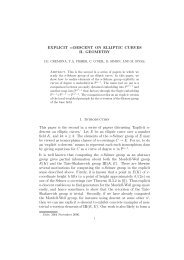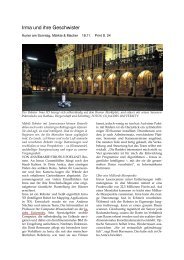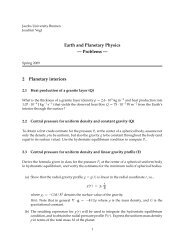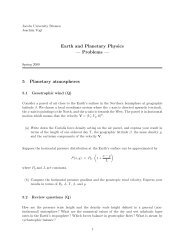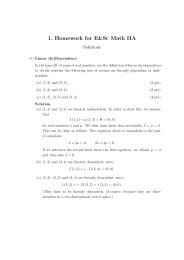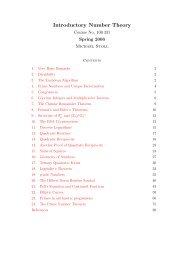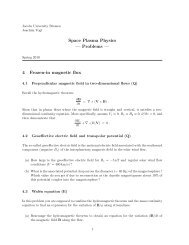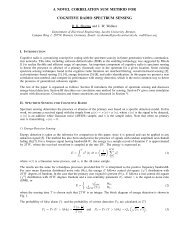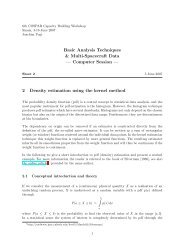Linear Algebra II (pdf, 500 kB)
Linear Algebra II (pdf, 500 kB)
Linear Algebra II (pdf, 500 kB)
Create successful ePaper yourself
Turn your PDF publications into a flip-book with our unique Google optimized e-Paper software.
24<br />
in a similar way as in Examples 7.2, and again they are pairwise inequivalent.<br />
Taking f(x) = x n , we have<br />
f1 = 1<br />
n + 1 , f2 =<br />
8. Bilinear Forms<br />
1<br />
√ 2n + 1 , f∞ = 1 .<br />
We have already seen multilinear maps when we were discussing the determinant<br />
in <strong>Linear</strong> <strong>Algebra</strong> I. Let us remind ourselves of the definition in the special case<br />
when we have two arguments.<br />
8.1. Definition. Let V1, V2 and W be F -vector spaces. A map φ : V1 × V2 → W<br />
is bilinear if it is linear in both arguments, i.e.<br />
∀λ, λ ′ ∈ F, x, x ′ ∈ V1, y ∈ V2 : φ(λx + λ ′ x ′ , y) = λφ(x, y) + λ ′ φ(x ′ , y) and<br />
∀λ, λ ′ ∈ F, x ∈ V1, y, y ′ ∈ V2 : φ(x, λy + λ ′ y ′ ) = λφ(x, y) + λ ′ φ(x, y ′ ) .<br />
When W = F is the field of scalars, φ is called a bilinear form.<br />
If V1 = V2 = V and W = F , then φ is a bilinear form on V. It is symmetric if<br />
φ(x, y) = φ(y, x) for all x, y ∈ V , and alternating if φ(x, x) = 0 for all x ∈ V . The<br />
latter property implies that φ is skew-symmetric, i.e. φ(x, y) = −φ(y, x) for all<br />
x, y ∈ V. To see this, consider<br />
0 = φ(x + y, x + y) = φ(x, x) + φ(x, y) + φ(y, x) + φ(y, y) = φ(x, y) + φ(y, x) .<br />
The converse holds if char(F ) = 2, since (taking x = y)<br />
0 = φ(x, x) + φ(x, x) = 2φ(x, x) .<br />
We denote by Bil(V, W ) the set of all bilinear forms on V × W , and by Bil(V ) the<br />
set of all bilinear forms on V. These sets are F -vector spaces in the usual way, by<br />
defining addition and scalar multiplication point-wise.<br />
8.2. Examples. The standard ‘dot product’ on R n is a symmetric bilinear form<br />
on R n .<br />
The map that sends ( a b ) , ( c d ) ∈ R2 × R2 a c<br />
to | b d | = ad − bc is an alternating<br />
bilinear form on R2 .<br />
The map (A, B) ↦→ Tr(A ⊤ B) is a symmetric bilinear form on Mat(m × n, F ).<br />
If K : [0, 1] 2 → R is continuous, then the following defines a bilinear form on the<br />
space of continuous real-valued functions on [0, 1]:<br />
1<br />
(f, g) ↦−→<br />
0<br />
0<br />
1<br />
K(x, y)f(x)g(y) dx dy .<br />
Evaluation defines a bilinear form on V × V ∗ : (v, φ) ↦−→ φ(v).



